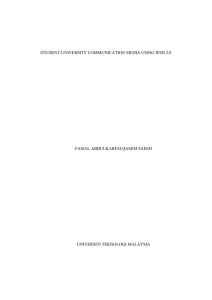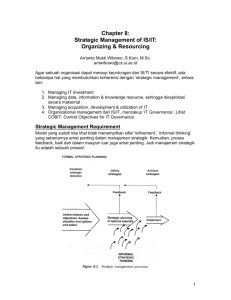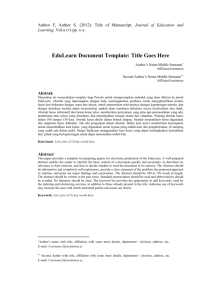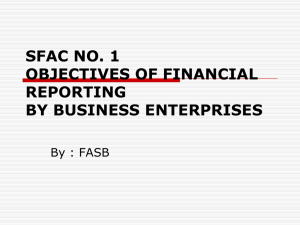Bab 1 - Pemrograman Terstruktur
advertisement
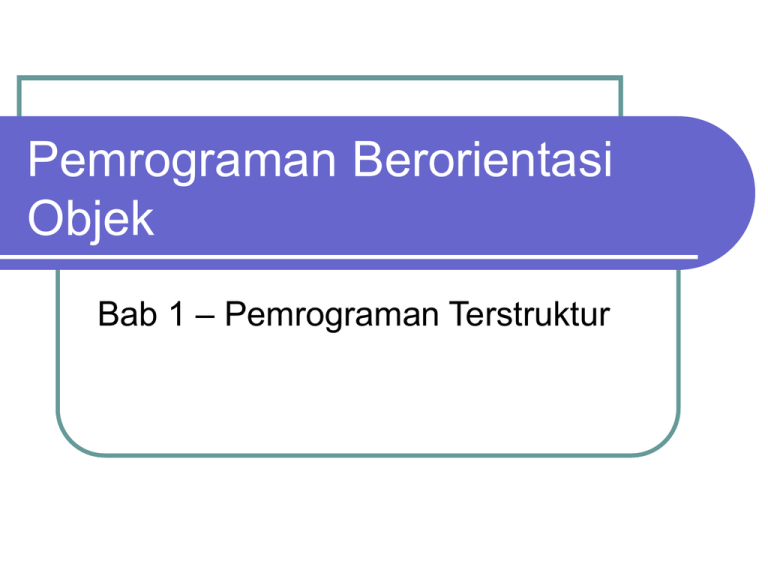
Pemrograman Berorientasi
Objek
Bab 1 – Pemrograman Terstruktur
Pemrograman Terstruktur
Adalah suatu proses untuk mengimplementasikan
urutan langkah untuk menyelesaikan suatu masalah
dalam bentuk program
Adalah teknik pemrograman secara berurut dan
terstruktur dalam: analisa, cara dan penulisan program
Prinsip dari pemrograman terstruktur adalah bahwa
apabila kita sudah sampai pada langkah tertentu, kita
tidak boleh mengeksekusi langkah sebelumnya. Hal
ini dikecualikan pada langkah-langkah untuk proses
berulang.
Tujuan PT
Untuk meningkatkan kualitas dan kehandalan
program
Untuk memudahkan pemahaman terhadap isi
program
Untuk menyederhanakan program
Untuk maintenance (pemeliharaan) program
Untuk meningkatkan produktifitas program
Sifat / Ciri PT
Gunakan rancangan pendekatan dari atas ke bawah
(top down design) -> program dimulai dengan
gambaran global yang dinyatakan dengan nama
prosedur/sub-rutin dan bukan isi detailnya
Bagi program ke dalam modul-modul logika yang
sejenis,
Gunakan sub-program untuk proses-proses sejenis
yang sering digunakan.
Gunakan pengkodean terstruktur: IF ... THEN, DO ...
WHILE dan lain-lainnya.
Menghindari penggunaan perintah GO TO bila tidak
diperlukan
Contoh PT
COBOL(Common Busines Oriented Language).
FORTRAN(FORmula TRANslator)
BASIC(Beginner All Purpose Symbolic Interchange
Code).
Pascal(Dinamakan untuk menghormati Blaise Pascal)
Ada (Dinamakan untuk menghormati Ada Lovelace)
C
Bentuk / Struktur Dasar PT
Sequence Structure: dieksekusi
berdasarkan urutannya.
Selection Structure: terdapat sejumlah
perintah yang dikerjakan tergantung dari
kondisi yang dipenuhinya.
Loop/Iteration Structure:
menggambarkan perulangan dari satu
atau lebih instruksi.
Sequence Structure
Selection Structure
Loop / Iteration Structure
Ex. PT
COBOL(Common Busines Oriented Language).
FORTRAN(FORmula TRANslator)
BASIC(Beginner All Purpose Symbolic Interchange
Code).
Pascal(Dinamakan untuk menghormati Blaise Pascal)
Ada (Dinamakan untuk menghormati Ada Lovelace)
C
Review PT dengan C
Susunan C:
Diawali dengan header library
Diikuti body
#include<stdio.h>
Variable Global
Function / Procedure / Method
Harus ada function main() sebagai titik masuk
program
int main() {
statements;
return 0;
}
Variable
Deklarasi variable:
<data type> <variable_name>(,
<variable_name_2 dst>);
int height;
int height, width;
Tipe Data Dasar
Tipe Data
Ukuran
Jangkauan
Format
Keterangan
char
1 byte
- 128 s/d
127
%c
Karakter
int
2 byte
- 32768 s/d
32767
%i atau %d
Integer /
bilangan
bulat
float
4 byte
- 3.4E-38
%f
s/d 3.4E+38
(7 digit)
Float /
bilangan
pecah
double
8 byte
- 1.7E-308
s/d 1.7+308
(15 digit)
Double /
bilangan
pecahan
presisi
ganda
%lf
Modifier
short
long
signed
unsigned
Struct
Digunakan untuk mendeklarasikan tipe data
baru yang berisikan kumpulan sejumlah
variable.
Array & Pointer
Array: kumpulan data sejenis
char j[20];
char j[] = {‘a’, ‘b’};
Pointer: variable yang berisi alamat memori
Bentuk umum: <tipe data> *<nama var>;
int v = 5;
int *p = &v;
printf("the value of p is %p\n", p);
printf("the value at that address is %d\n", *p);
Flow Control
Selection / Branching
If Else
? : Operator
Switch Case
Iteration / Looping
While
For
Break & Continue
If Else
if (expression) statement;
or
if (expression) { Block of statements; }
or
if (expression) { Block of statements; }
else { Block of statements; }
or
if (expression) { Block of statements; }
else if(expression) { Block of statements; }
else { Block of statements; }
If Else Sample
? : Operator
condition ? X : Y;
Switch Case
switch( expression ) {
case constant-expression1:
statements1;
break;
[case constant-expression2:
statements2;
break;]
[case constant-expression3:
statements3;
break;]
[default :
statements4;
break;]
}
Switch Case Sample
While
while ( expression ) {
Single statement;
or
Block of statements;
}
do {
Single statement;
or
Block of statements;
} while (expression);
While Sample
For
for(expression1; expression2; expression3) {
Single statement;
or
Block of statements;
}
expression1 - Initializes variables.
expression2 - Conditional expression, as long
as this condition is true, loop will keep
executing.
expression3 - expression3 is the modifier
which may be simple increment of a variable.
For Example
Break & Continue
break -- exit form loop or switch.
continue -- skip 1 iteration of loop.
Function / Procedure / Method
Adalah sebuah module / blok code program yang
berurusan dengan sebuah tugas tertentu.
Functions punya 2 tujuan:
They allow a programmer to say: `this piece of code does a
specific job which stands by itself and should not be mixed up
with anyting else',
Second they make a block of code reusable since a function
can be reused in many different contexts without repeating
parts of the program text.
Function dapat memiliki sejumlah parameter,
melakukan pemrosesan dan kemudian dapat
mengembalikan sebuah nilai (bisa Y/N).
Function
<return type> <name>(<param1,
[param2, dst]>) {
statements;
[return value;]
}
return type:
void
data type ttn
Function Sample


